Cree organizer Clayton Thomas-Muller provides a personal account of a ceremonial healing walk through the broken landscape of Canada’s tar sands. This year’s walk took place between July 4th and 6th and we include a video and quotes from participants.
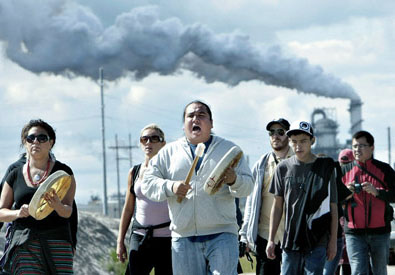

A Healing Walk through Canada’s Tar Sands Dystopia
By Clayton Thomas-Muller, Published in Yes Magazine
A couple years ago I was asked by the Keepers of the Athabasca to be Master of Ceremonies for a unique event: the first annual walk to heal the Canadian tar sands.
It took place in the region of the most controversial energy project on earth. The idea was not to have a protest, but instead to engage in a meaningful ceremonial action to pray for the healing of Mother Earth, which has been so damaged by the tar sands industry. Members of the five First Nations of the Athabasca region and residents of the nearby town of Fort McMurray, Alberta, tired of the never-ending fight with Big Oil and its supporters in the Canadian government, had made a conscious choice to protect their way of life. This was done by turning to ceremony and asking through prayer and the physical act of walking on the earth for the hearts of those harming Mother Earth through extreme energy extraction to be healed.
[vimeo clip_id="69882514"]
Protecting the Sacred One Step at a Time – from Zack Embree – Tar Sands Healing Walk 2013
By extreme energy extraction, I’m talking about practices like tar sands mining and fracking, which the oil and gas industry has had to resort to now that most of the easy-to-find liquid crude is gone. By scraping the earth for fossil fuels that are mixed with sand and rock, these techniques do tremendous damage to the places where they occur.
My journey started in Fort McMurray, also know as tar sands boom town. Many have described this place as the land of milk and honey, a place were you can trade five years of your life (and soul) and be financially “set up.” I met with a motley crew of activists, elders, and youth from Fort Chipewyan, Fort McKay, Anzac, and the metro areas of Calgary and Edmonton, as well as some allies who had traveled from as far as British Columbia and beyond.
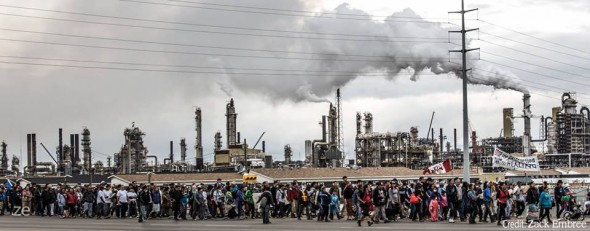

The plan was to take vehicles to the beginning of the infamous stretch of road that branches off of Highway 63 to form a ring through the tar sands. This road has gained a notorious reputation due to the many people killed in accidents there—including 46 between 2007 and 2012. Its traffic rivals that of downtown New York City, and gets especially heavy during two daily shift changes.
“I’m here because we cannot allow the tar sands to expand, we cannot allow all the oil here to be taken out of the ground, and the best way to stop the reckless greed driving their expansion is to block off the ability of these companies to export the oil. If we block the Northern Gateway and Kinder Morgan pipelines to the West, the Keystone XL pipeline to the South and the Line 9 reversal, which we will be fighting in Quebec, we can force them to keep the oil in the soil.” — Gabriel Nadeau-Dubois, former spokesperson for CLASSE.
Our plan was to pray, make offerings to the four directions, and walk through the heart of tar sands development as concerned elders, parents, and youth.
Highway 63 is the only road to Fort McKay Cree Nation, one of Canada’s wealthiest yet most polluted First Nations, where water needs to be trucked in daily to meet the community’s needs. The highway loops past vast human-made deserts in the form of tailings ponds wet and dry, and then past an archaic Suncor/Petro-Canada facility with black carbon-stained cracking towers that belch hellfire into the morning sky. The highway finally meets the junction that leads to Fort McKay and continues onward past the industrial metropolis that is Syncrude, Canada’s largest tar sands operator, operated largely by ExxonMobil.
The Syncrude site is like something straight out of a science fiction movie. From the road, you can see glimmering stainless steel cracking towers that separate bitumen into synthetic oil, a massive tank farm, lego-like worker sleeping facilities stacked upon one another, and two half-built pyramids of sulfur (a by-product of the bitumen upgrading process) being built toward the sky like modern Towers of Babel.
“To me the tar sands are really the epitome of this way of looking at the world which is all about compartmentalization, and telling ourselves that we can treat the earth like a machine, our bodies like a machine and just dismantling the natural world, and pretending we can put it back together again, when we obviously can’t. This event is also about respecting our teachers in this fight, who have been the First Nations peoples most affected by the tar sands. It’s not just that they’re saying ‘no’, they’re also offering us a ‘yes’, another way of seeing the world that is far less violent, that is much more respectful. To me, this event is important because it is embodying that other way of being.” — Naomi Klein, author and activist
Then comes what is probably the most absurd element of insanity on the Highway 63 loop: the buffalo demonstration project and reclamation site.
Yeah, you heard right. Some executive from Syncrude got it into their head that having live buffalo living under the stacks of their tar sands upgrader would be a good thing for the image of the tar sands industry. A herd of the most symbolic animals of our native heritage is subject to a slow poisonous death, its members grazing in toxic fields with an apocalyptic backdrop of tailings ponds and smoke stacks billowing white clouds of toxic death overhead.
But the absurdity doesn’t end there. A few years back, some of these poor beasts were culled and distributed to elders in local First Nations. Instead of eating it, they had it sent away and tested. The tests came back showing that the meat was poisoned with heavy metals and other toxic compounds, which was present in concentrations hundreds of times above what is deemed acceptable for human consumption.
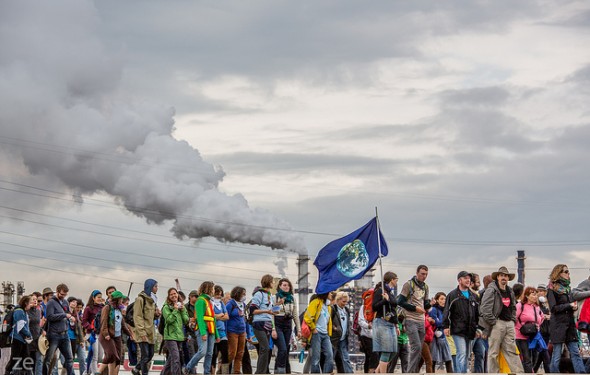

Shattered landscapes
During our preparations for the walk we discussed many fears about the risks involved in exposing our community to the contaminated and dangerous environment. Walkers were also scared that police would arrest them. Another fear was of the tar sands workers whizzing past us at 60 miles an hour or more in their semis and pickup trucks, as well as the infamous tar sands dump trucks, which are so large they look like a three story suburban home on wheels.
“This event is incredibly important to the tar sands campaigns, the pipelines campaigns, the movement as a whole, because we are connecting here to the real community impacts and learning from the grace and the courage of First Nations here who are experiencing the impacts of the tar sands in their daily lives. This land deserves to live, and not be destroyed.” — Winona LaDuke, environmental activist and U.S. vice-presidential candidate.
With these fears in our minds, we chose to listen instead to our hearts and to allow ourselves to be led by local First Nations elders into the tar sands Highway 63 loop. What I saw on the walk generated such a twisted feeling in my heart that I feel like I cannot articulate it. But I can try.
The landscape was unlike anything I had ever seen before. I walked past a tailings pond so big that it covered the horizon for miles, fed by a 24 inch wide pipe spewing a yards-high flow of liquid hydro-carbon waste so toxic that water fowl who land in it die within minutes. We saw from up close the hell-fires of the Suncor/Petro-Canada stacks, with their 50-foot flames shooting up into the sky. I wondered what madness allowed Suncor to build them 500 meters away from the precious Athabasca River, which so many First Nations, Metis, and Inuit communities depend on for water.
No matter how many photos you have seen, how many videos you have watched, nothing can prepare you for what we saw. For the stark reality of an earth used up and ready to be thrown away. Dead birds dotted the roadside, a child reached for a raspberry tantalizingly hanging from a bush, only to be yanked away. — Ethan Cox in The Tyee
As we walked, I pondered all of the battlefields that the emerging international movement to stop the tar sands and its associated infrastructure of pipelines, refineries, and shipping lanes is engaged with. I was overcome by the magnitude of our undertaking, picking a fight with the most inhumane and wealthiest corporations on the planet. As I put one foot in front of the other, I realized that if we did not focus our best efforts on stopping the era of extreme energy that this wasteland represented, we would be locked into a series of never-ending fights against pipelines, shipping lanes, and refineries across the continent.
No, I thought, that cannot work. This beast must be smothered to death at the source.
httpvh://youtu.be/2iag76GyHk0
From Occupy Love, directed by Velcrow Ripper. Produced by Nova Ami, Velcrow Ripper & Ian MacKenzie. Music in these scenes by Christen Lien and Zoe Keating. Learn more at http://www.occupylove.org
A powerful ceremony
At the beginning of the day, before the walk started, we argued about the right way to do the ceremony. What I know is that a bear showed itself to us at the start of our walk and that it carried with it the teachings of courage and protection. Later, an eagle flew over us and it represented the teaching of truth and unconditional love.
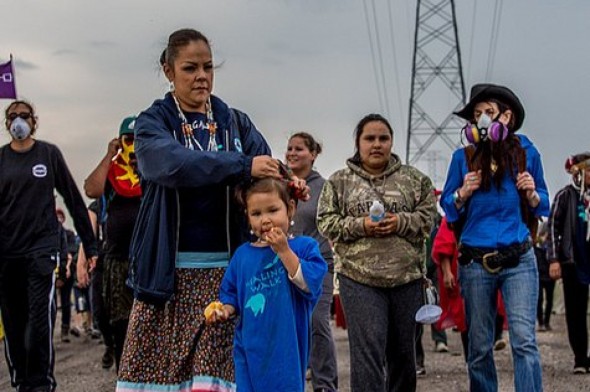

While we walked, we made offerings of tobacco and water on four strategic points along Highway 63. We prayed to each of the four directions and to called upon spirit, creator, mother earth, and all of the sacred elements to both heal the land and to touch the hearts, minds, and spirits of those responsible for her desecration. This was done so that the people destroying her could truly understand what they were doing. And wake up.
We did not get a huge global media sweep when our walk was finished. As a matter of fact, many of us got sick with what would become known in subsequent healing walks as the tar sands healing walk flu. We also found that our biggest supporters during that first walk were the tar sands workers and Fort McKay community members honking their horns and boosting our spirits with every honk. (The children on the walk made it a game to get the drivers to honk).
The tar sands healing walk was one of the most powerful ceremonies I have ever been a part of, comparable to our most sacred ceremony back home: the Sundance.
Something happened when we all decided to take a break from the battle with Big Oil, national and provincial governments, and the banks that finance them. When we decided to instead focus all of our intentions, our power and our love on healing our most sacred Mother and those that depend on her health through prayer, ceremony, and the physical act of walking together, we led with our hearts.
Healing Walk 2013
This year’s Healing Walk will be number four, which in many native circles is a very significant number: four directions, four nations of the earth. This walk marks the end of one cycle and perhaps the beginning of a new one in the battle against Big Oil.
This year’s walk and associated events will take place in Fort McMurray from July 4 to 6. The former Chief of Smith’s Landing Treaty 8 First Nation and respected Dene Elder Francois Paulette and the Athabasca Chipewyan Dene Nation Chief Allan Adam will both be speaking at a pre-conference on July 5 in the Metis settlement of Anzac.
They will be joined by author, activist, and founder of 350.org Bill McKibben; author and 350.org board member Naomi Klein; former U.S. vice presidential candidate, author, and Native American activist Winona LaDuke; and First Nations hip hop artist and activist Wabanakwut (Wab) Kinew.
Clayton Thomas-Muller is a member of the Mathias Colomb Cree Nation, also known as Pukatawagan, in Northern Manitoba, Canada. Based out of Ottawa, Ontario, Canada, Clayton is the National Campaigner with the Defenders of the Land-Idle No More campaign known as Sovereignty Summer and the co-director of the Indigenous Tar Sands Campaign of the Polaris Institute. Follow him on Twitter @CreeClayton.



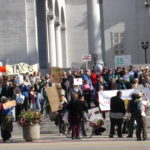
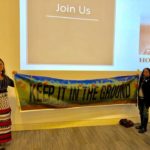
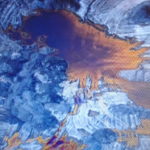
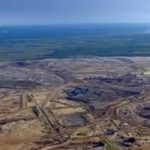






Pingback: Idle No More LA: Poetry and Prayer at Petroleum Conference | WilderUtopia.com